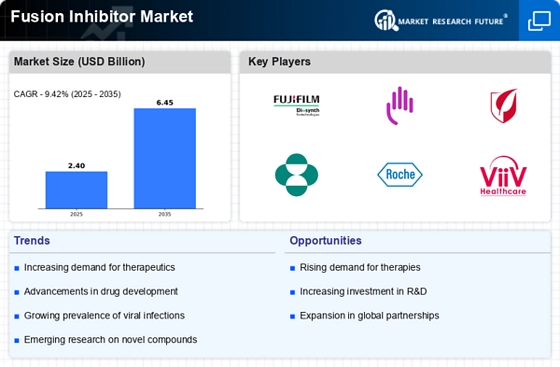Growing Investment in Biotechnology
The increasing investment in biotechnology is a pivotal driver for the Fusion Inhibitor Market. In recent years, venture capital funding for biotech firms has surged, with investments reaching over $30 billion in 2025. This influx of capital is facilitating the development of innovative therapies, including fusion inhibitors, which are essential in combating viral infections. Furthermore, public-private partnerships are emerging, fostering collaboration between research institutions and pharmaceutical companies. These partnerships are likely to enhance the research landscape, leading to the discovery of new fusion inhibitors and expanding the market. As the biotechnology sector continues to thrive, the Fusion Inhibitor Market stands to benefit from enhanced research capabilities and increased product offerings.
Rising Awareness of Antiviral Therapies
There is a notable increase in awareness regarding antiviral therapies, which is positively impacting the Fusion Inhibitor Market. Educational campaigns and advocacy efforts are informing both healthcare professionals and patients about the importance of early intervention in viral infections. As of 2025, surveys indicate that over 70% of healthcare providers recognize the role of fusion inhibitors in treatment protocols. This heightened awareness is likely to lead to increased prescriptions and utilization of fusion inhibitors, as clinicians seek to provide comprehensive care for patients with viral infections. Consequently, the Fusion Inhibitor Market is expected to experience growth as more patients gain access to these critical therapies.
Increasing Prevalence of Viral Infections
The rising incidence of viral infections, particularly those caused by HIV, has catalyzed the demand for innovative treatment options within the Fusion Inhibitor Market. As of 2025, it is estimated that approximately 38 million people are living with HIV worldwide, necessitating effective therapeutic interventions. Fusion inhibitors, which prevent the virus from entering host cells, are gaining traction as a viable treatment strategy. This trend is further supported by the increasing awareness and education surrounding viral diseases, leading to higher testing rates and subsequent treatment initiation. Consequently, the growing patient population is likely to drive the expansion of the Fusion Inhibitor Market, as healthcare providers seek to incorporate these advanced therapies into their treatment regimens.
Regulatory Support for Innovative Therapies
Regulatory bodies are increasingly supportive of innovative therapies, which is a crucial driver for the Fusion Inhibitor Market. Recent initiatives aimed at expediting the approval process for breakthrough therapies have created a favorable environment for the development of fusion inhibitors. As of 2025, several fusion inhibitors have received fast-track designations, allowing for quicker access to the market. This regulatory support not only encourages pharmaceutical companies to invest in research but also enhances patient access to novel treatments. As the regulatory landscape continues to evolve, the Fusion Inhibitor Market is likely to benefit from a more streamlined approval process, fostering innovation and expanding treatment options for patients.
Advancements in Drug Development Technologies
Technological innovations in drug development are significantly influencing the Fusion Inhibitor Market. The advent of high-throughput screening and computational drug design has accelerated the identification of potential fusion inhibitors, enhancing the efficiency of the research and development process. As of 2025, the market is witnessing a surge in the number of clinical trials focused on fusion inhibitors, with over 50 ongoing studies aimed at evaluating their efficacy and safety. These advancements not only streamline the development pipeline but also reduce the time required to bring new therapies to market. As a result, the Fusion Inhibitor Market is poised for growth, driven by the introduction of novel compounds that address unmet medical needs.























Leave a Comment